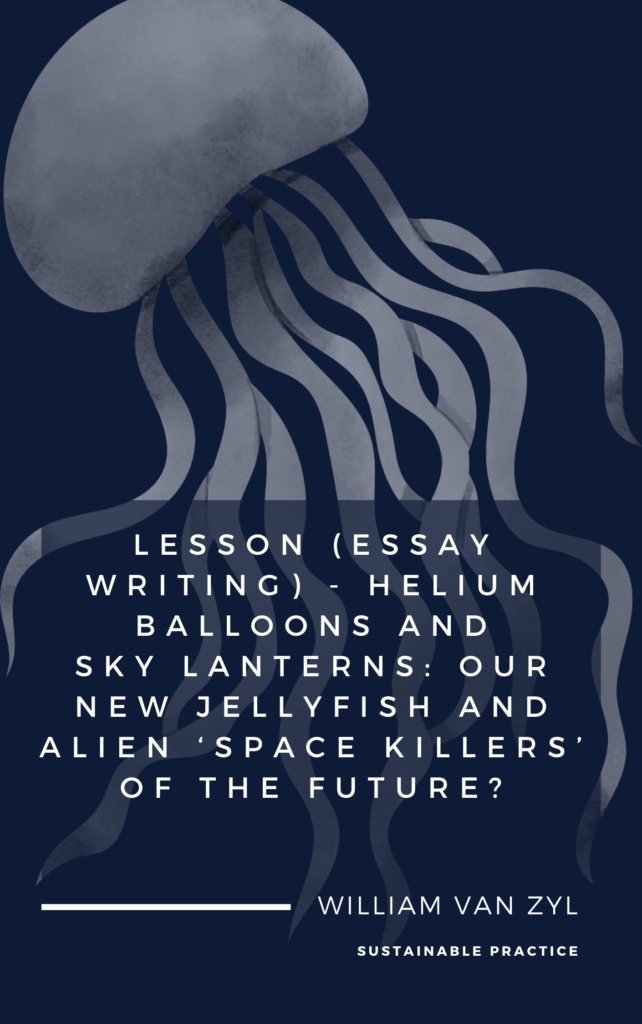$0.00
Description of the product:
A lesson with resources: Essay Writing – Secondary school students. 17 pages. 2600 words. Several images are included.
Excerpt:
Soft bait is a silent killer.
Synthetic fishing lures have been developed to catch any type of freshwater and saltwater fish. Designers and manufacturers have spent large amounts of money, time, and resources, on developing the most effective lures and soft baits. Soft bait is so effective that in some instances, it is far more effective and successful than organic bait. It kills.
The question: how can soft bait silently kill thousands?
When a helium balloon pops hundreds of meters – high up in the sky – it glides and floats down as soft bait. The Maori Sky Father (New Zealand context) – Ranginui – immediately issues a warning:
Alert! Alert!
(Kia Mataara,
Kia Mataara!)
Rubber jellyfish, rubber octopuses, and rubber sea anemones plop into our oceans every day. The colour of the ‘bait’ is bright and enticing. It moves in the water, waving its tentacles and arms, inviting sea life to come closer. As if performing a magic trick, it says, ‘Eat me, please eat me!’ For sea turtles, it is camouflaged as a silent killer. Other sea life and birds are also affected.
Nevertheless, what can we do to solve this problem? Sky lanterns also pose a threat. The lanterns are more biodegradable than balloons; right? The beautiful floating lanterns lits up the sky for our enjoyment. Large paper ‘bags’ – propelled by burning candles suspended just below the mouth of the bags – are made of paper; right? Green designers — please listen and investigate — there are metal parts in the Sky Lanterns!
Let’s continue to look at helium balloons. Moreover, for sea turtles, it is camouflaged as brightly coloured jellyfish. Other sea life and birds are also affected. When digested, it blocks the animal’s intestines. Do we take enough notice? What are we doing about it? With many sea turtles dying, and other sea and water life affected, we have a decision to make. The question is, do we want helium balloons, or do we want sea turtles? We can’t have both. Will we choose short-term entertainment, or will we choose to keep sea turtles alive in their natural habitat. When sea turtles mistakenly eat balloons as jellyfish, they die. While most ocean animals confuse burst balloons as food, other sea and freshwater creatures also see the deadly rubber as edible. Interestingly, when researchers looked at the death of 1733 seabirds, from 51 species, they found that one in three birds had ingested balloons. Plastic and rubber in our oceans are a huge problem…

A modern version of a sky lantern. How many metal parts are there in this lantern? Credit Pixabay.com.

Typical Sky lanterns. Those supportive rings, are made from bamboo or wire? Credit: Pixabay.com
Description
Instruction to students: Write a 1000-Word Essay (Writing exercise).
Read the article as a blog post: https://fivehousepublishing.com/2021/10/08/helium-balloons-and-sky-lanterns-our-new-jellyfish-and-alien-space-killers-of-the-future/
When a helium balloon pops hundreds of meters – high up in the sky – it glides and floats down as soft bait. The Maori Sky Father (New Zealand context) – Ranginui – immediately issues a warning:
Alert! Alert!
(Kia Mataara,
Kia Mataara!)

Floating jellyfish over a city. It carries a message.’
Write a 1000 word essay of Helium balloons and Sky lanterns and discuss the devastating effects on the marine life of our oceans. Focus on hooking in the reader — provide an interesting introductory paragraph. Choose a title for the essay that draws attention and pops. Compare and contrast some of the research data and other known facts. Use the exemplar essay for inspiration. By using your current writing skill — and challenging yourself —improve your paragraph writing, your sentence styles, punctuation, and more in the process.
Plan your essay. Show your planning (take a picture and add it at the end of your essay. Share it with your teacher (Google Doc). For example, show the introductory paragraph, the body (middle), and the concluding paragraph. Take the body paragraph and carefully plan how you would use your research data.
You could use helium balloons and Sky lanterns for your essay. However, if you want to write about something else, that harms the environment, feel free to use it.
Learning intention:
- Hooking the reader in with an exciting and compelling introduction.
- Spend time on your very first sentence, crafting a uniquely designed sentence.
- Planning and structuring of the paragraphs.
- Include comparison and contrasting of two subjects: E.g. helium balloons and sky lanterns.
- Exploring the sustainable practice of these items and the impact on the environment (parts, movement, animal behaviour, and more).
- Conclusion: delivering a power sentence/paragraph at the end (short/ powerful/pro-active).
- Providing additional links and resources to inspire young writers to write on the topics of helium balloons and sky lanterns in the environment. Young writers could explore other sustainable aspects and other unsustainable ideas related to the named subjects — harming the environment. For example, meteorologists’ helium balloons pop high up in the sky and eventually falls to earth. Skyfall. It could reach land, the ocean, a river or a dam. Though we all need weather data, how could these large rubber balloons influence the environment? Are alternative solutions available? Are there other methods to collect weather data?
This lesson was inspired by the Write that Essay (WTE) education company in New Zealand.
See https://www.writethatessay.org/. 12-sentence styles, paragraph styles, and more.
Here is an indication of some of the things teachers are looking for:
STRUCTURE Essay relevant to the topic. Topic covered in depth. Interesting introduction — setting the scene. Strong conclusion (referring to important points in the body). Pro-activity — offer a solution or idea.
ARGUMENT Accurate presentation of evidence. Logically developed argument — original and creative thought.
STYLE Fluent piece of writing. In other words, a natural flow of argumentation. Succinct writing (accuracy).
PRESENTATION Legible and well set out work. Reasonable length (meets the requirements given by the teacher).
SOURCES Adequate acknowledgement of sources. For example, when an image is used.
MECHANICS Grammatical correctness of sentences (e.g. tenses). Correct spelling throughout. Effective use of figures and tables (data/graph/diagram). Correct use of units and quantities.
CREATIVITY AND INNOVATION Are there evidence of creative processes used to write the essay. The teacher is looking for originality! Break the rules in some instances. A caveat though, not too much outside the square thinking. Remember it is a 100-word essay. Stick to the essay writing rules.






